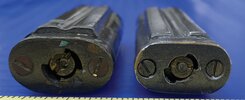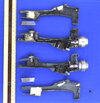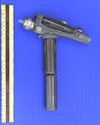If we are going to continue to discuss it's potential accuracy in a useful way, instead of attacking each other, then can someone please comment (intelligently) on the photo I've attached. Since one of these is the auction phaser and the other is a Jein hero, this area seems the most different to me, including a different trigger length. Are these differences within the margin of error in a vintage prop ? This is a serious question. (Please answer without trolling)
First I take "extreme offense" at you're accusing me of so much as
attacking anyone... (ahem, aside from the "French Fries" comment. I probably should have said
Potato Chips or Cheetos from the get-go. But honestly, a few of you on here need to develop a sense of humor about life and not be so serious).
SO and okay, what we genuinely have at stake here is the
value and Provenance of the history of this,
the ultimate in
Star Trek Props.
In the effort to nullify this current
besmirching and thereby possibility of reducing the estimated multiple six-figure value of what has
officially been sanctioned by
"those who know" as a genuine "Hero Phaser Pistol", I have had a phone discussion during the last hour with one of those principal's who evaluated this
thingy.
As
I'd expect you all already know; the 1966 originals were not made by Wah Chang, and were originally painted Black & White with the BRASS grip painted white. They did NOT have any functioning aspects. No lights, no moving parts, they were simple and true "Props". These "Hero's" were later made to light and have operating features and that two tone grey re-paint, all this work having then been done by Wah Chang.
From the attached opened up image,
I can see these are internally identical and were modified to operate in precisely the same manner and by the same person at the very same period in time. To disagree with this as fact, would simply be put as,
foolish.
And from what I have now been told, of the four original "Hero Phaser Pistols", no two have identical trigger buttons either in length or diameter, (whatever was handy in aluminum rod having been used back in the day. ) Also, these two weigh virtually the same in one's hand and of most significance; they are identically painted, in exactly the same fashion and with the
absolutely identical shades of gray.
---That no one on here so much as commented on this matching paint is remarkable. And just
how probable would that be with a copy/fake?
So to revisit why I feel several of you guys are insisting this is a fake:
It still comes off as simple "envy". And as misery loves company, what I see happening here is the following:
"Why don't we all 'Group Think' style, tear this sucker down and reduce it's Auction Price potential!"
Or, put another way, an:
"If I can't have it, no one can" mentality.
But back to the history: When Wah Chang added the inner workings he back-filled the polyester/fiberglass shells with multiple layers of epoxy resin in order to secure these numerous internal working components and operating springs, electrical and mechanical wires etc. and that is what shows. See for yourselves.
You asked if these are resin or fiberglass. The shells are Polyester resin and a light weave of fiberglass cloth. The additional layers (many!) of epoxy is visible in the attached images as is....
"WHAT!!
A "Phaser 'Three'" ...you query?? HOW would that be possible
IF they aren't BOTH genuine and original
"Star Trek, Hero Phaser Pistol Props"?
Right there guys, these photos (NOT to be found anywhere else!)
are my "Stinking Badge", ... So are you guys satisfied now?




